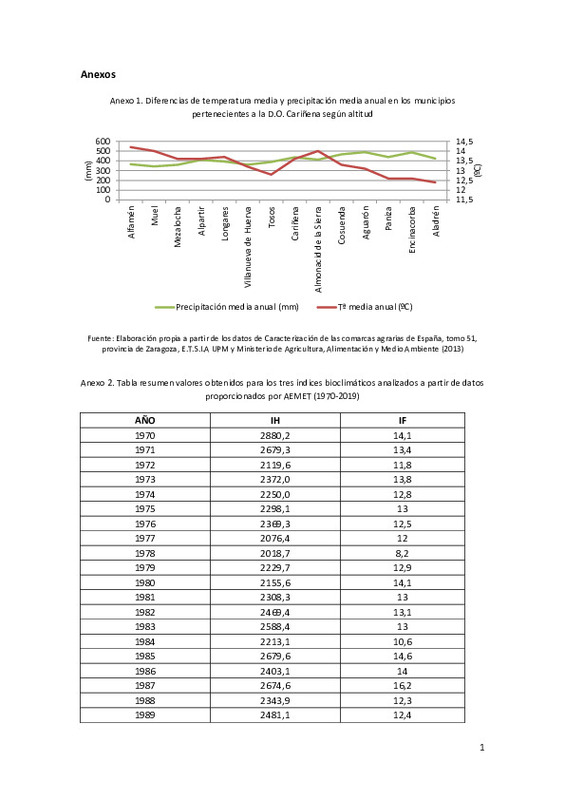|
Resumen:
|
[ES] El cambio climático es especialmente grave en el sistema agrario, por su dependencia medioambiental. Uno de los sectores más sensibles es el vitivinícola, por la influencia del clima sobre la cantidad y la calidad de ...[+]
[ES] El cambio climático es especialmente grave en el sistema agrario, por su dependencia medioambiental. Uno de los sectores más sensibles es el vitivinícola, por la influencia del clima sobre la cantidad y la calidad de la cosecha. Además, afecta a la tipicidad de los vinos de cada zona, lo que preocupa especialmente a las denominaciones de origen, que quizá deban introducir cambios en sus reglas de funcionamiento, con el fin de que los productores puedan adaptarse.
En este trabajo se analiza de qué manera afecta el cambio climático al sector vitivinícola en la Denominación de Origen Cariñena, localizada en la provincia de Zaragoza (Aragón), ubicada en pleno valle del Ebro, una zona mediterránea con escasas precipitaciones y temperaturas elevadas en verano.
En una primera parte se analizan a) las variaciones ocurridas en los parámetros climáticos de la zona en las últimas décadas, b) los escenarios futuros probables, c) los índices bioclimáticos relacionados con el viñedo y d) los impactos que pueden producirse en el viñedo de la zona, así como las consecuencias sobre la rentabilidad y viabilidad del cultivo.
Con la caracterización climática de la zona de estudio, el TFM demuestra que se han producido cambios sustanciales en los últimos 50 años que afectan a la idoneidad del cultivo, como el continuo aumento de la temperatura media, o el descenso de las precipitaciones. De igual manera, todas las proyecciones y escenarios futuros indican que en los próximos años estos cambios seguirán acentuándose, lo que dificultará cada vez más una adecuada adaptación del viñedo.
En una segunda parte, al examinar las principales estrategias de adaptación que suponen costes de inversión y cambios de modelo productivo para los viticultores, se concluye que la medida más económica y rápida es el cambio de variedad mediante reinjerto, pero también es la que menor efecto tiene. Por el contrario, la medida con mayor alcance, pero la más costosa y que mayores dificultades conlleva, es la deslocalización del viñedo.
Por último, se realiza un análisis de la realidad vitícola de la zona, en el que se comprueba que la percepción que tienen los viticultores sobre el cambio climático está muy influenciada por el modelo vitícola que practican, siendo más sensibles las zonas con viñedos antiguos y sin acceso a recursos hídricos.
[-]
[EN] Climate change is especially serious in the agricultural system, due to its environmental dependence. One of the most sensitive sectors is the wine sector, due to the influence of the climate on the quantity and quality ...[+]
[EN] Climate change is especially serious in the agricultural system, due to its environmental dependence. One of the most sensitive sectors is the wine sector, due to the influence of the climate on the quantity and quality of the harvest. In addition, it affects the typicity of the wines of each area, which is of particular concern to the denomination of origin, which may have to introduce changes in their rules of operation, so that producers can adapt.
The aim of this TFM was to analyse how climate change affects the wine sector in the Cariñena Denomination of Origin, located in the province of Zaragoza (Aragón), in the Ebro Valley, a Mediterranean area with low rainfall and high temperatures in summer.
The first part was focused on the analysis of a) the variations that have occurred in the climatic parameters of the area in the last decades, b) the probable future scenarios, c) the bioclimatic indexes related to the vineyard and d) the impacts that can occur in the area¿s vineyards, as well as the consequences on the profitability and viability of the crop.
With the climatic characterization of study area, this TFM demonstrates that in the last fifty years there have been important changes which affect the suitability of the crop, such as the increase in the average temperature, or decrease in rainfall. Similary, all future projections indicate in the coming years, these changes will continue to increase, making more difficult the adequate adaptation of the vineyard.
In a second part, the main adaptation strategies will be examined, involving investment costs and changes in the production model for wine growers. It is concluded that the cheapest and fastest measure is the change of variety, bus this measure is the one with the least effect. On the contrary, the measure with the greatest scope, but the most expensive and the one that presents the greatest difficulties, is the relocation of the vineyard.
Finally, the wine sector reality is analysed to verify if it corresponds to the changes in the environment. It shows that the perception that wine growers have about climate change is highly influenced by the wine model they practice, being areas with older vineyards and without access to irrigation more sensitive.
[-]
|








